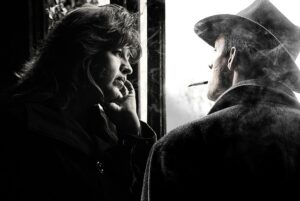What is expository writing? This is a question that many people have, especially when it comes to thrillers. Expository writing is a process that helps writers explain complex ideas or concepts to their readers.
This blog post will discuss expository process writing and some tips on using it in your thrillers.
Expository Writing Basics – What it is and why it’s essential for thrillers
Writing an expository essay provides numerous benefits for thriller writers. It requires writers to explore and explain complex topics or ideas; it’s an opportunity to refine your understanding of the craft and hone your ability to draw readers in with captivating story-telling.
One key advantage of expository writing is that it allows for deeper detail when describing characters or events within your story. Going further than surface-level descriptions, this type of literary technique gives readers a fuller understanding of what’s taking place in the narrative or who its main players are.
An excellent way for thriller writers to sharpen their skills and gain inspiration is to write expository essays.
Crafting a Plot – Setting up the story and creating suspense
Establish the facts first before spinning your tale
When adding exposition to your story, readers have time to become acquainted with all aspects of what makes your story unique and exciting.
As a thriller writer, you will likely be tempted to jump into dramatic action sequences immediately; however, if you want your work to stand out from other thrillers, you should establish all pertinent facts about the setting and characters before beginning your story-telling journey.
Choose only necessary facts. Too much information will make your novel feel like a history lesson, so you should focus on adding relevant and exciting facts to further your plot. Please make sure these facts are well-researched before including them in your work.
Creating Characters – Building memorable characters with depth and complexity

Provide just enough details
When writing a thriller, expository writing can help you set up the story and introduce important characters or events necessary for the story to progress. Using this type of writing, you can provide your reader with information about the backstory and any crucial details that will help them understand and follow the narrative.
Descriptive essays can also be used for heightened dramatics—by emphasizing certain facial features (that can indicate character traits), physical gestures (that show particular mannerisms/habits), or dialogue snippets (that delve deep into emotions).
Make sure not to give too much information at once as this can slow down your story or overwhelm your readers; focus on providing just enough details about characters’ backgrounds, history, etc., so that readers stay engaged without becoming bored or confused by excessive content.
Here is an exposition example from Stephen King’s Misery:
“Annie Wilkes was born on April first nineteen forty-nine…She had once been a nurse at City Hospital but resigned four years ago under the circumstances not made clear…She had become involved with several episodes that ended disastrously during her tenure.”
The power here lies in how vivid imagery conjured solely by exposition effectively creates plenty of suspense without needing much additional embellishment through dialogue or plotlines – it’s up to the readers, at this point, to figure out what role Annie plays going forward!
Dialogue Techniques – How to write effective dialogue that moves the plot forward

Keep exposition relevant
The most frequent exposition technique used in thrillers is dialogue. This allows writers to keep the story moving while revealing critical details to the audience without having them feel like they are being lectured on something. Here are some of the techniques authors use when writing dialogue for expository purposes:
Metaphor & Similes:
Metaphors and similes often have double meanings and can reveal deeper meanings about a character or situation than what is said outrightly. For example, in Alfred Hitchcock’s Psycho (1960), Norman Bates talks about his mother, saying, “She’s not herself today.” That line has layers of filmic meaning – her mental health issues – beyond conveying her current state of mind.
Foreshadowing:
If a protagonist says something that foreshadows upcoming events or provides clues to certain aspects of the mystery, this could be considered exposition through dialogue too! For example, in Memento (2000), Leonard Shelby talks about how his memory works, saying, “I’m telling you I don’t remember…Short-term memory goes back only so far!” This clue points forward to events that will later take place in the movie without coming out directly and stating it now.
Explanatory paragraphs:
Overall, explanatory paragraphs are incredibly useful when successfully executed in thrillers. They can bring vivid descriptions alive within your story, such as “The phone felt heavy with dread in Rebecca’s hand” or “Her heart raced faster than a cheetah.” This helps draw readers into your narrative and keep their attention, so they don’t lose focus on what is happening in each scene.
Thesis statement:
A thesis statement in expository writing is an argumentative statement that summarizes the main points of a thriller’s narrative. It justifies why the reader should believe the writer’s perspective. For example, a good thriller writer might create a thesis statement like this: “In Stephen King’s The Shining, Jack Torrance’s inner demons drive him towards his ultimate downfall.”
Utilizing Suspenseful Language
Vary sentence structure and vocabulary throughout
One easy way to add complexity and interest to your piece is by switching up sentence structures, i.e., short vs. long ones, changing up active vs. passive voice, playing with personification, etc. Similarly, varying word choices throughout can help develop believable characters who come across as real people.
Don’t be afraid to get creative with the description. When crafting scenes for your novel, don’t just settle for generic descriptions; instead, use vivid language that brings the scene to life and allows readers to form a solid mental image of the setting.
You can do this through careful word choice, creating metaphors, foreshadowing events, adding mysterious characters or settings, and using a wide range of descriptive words that evoke emotion.
Here are a few more exposition examples from popular thriller novels:
“The Tyrannosaurus rex stood twelve feet high at the hips…It was sixty feet long from snout to tail tip…Its tiny forelimbs were clenched like fists…Its hind legs were slender columns supporting its enormous bulk…” Jurassic Park by Michael Crichton
“The mountains were still there, of course…but it seemed to him now that they watched over him like ancient beasts who had grown tired of this part of their dance through eternity. That same sense of being watched made Jack feel alive and excited – sure, he hadn’t succeeded yet, but at least he knew what he was aiming for now.” The Shining by Stephen King
“What I remember most about the beginning of my marriage: fresh peaches and salt air. We had spent our wedding night on North Brother Island – a speck of City Island where New York trains its new correctional officers, but it seemed miles away from civilization, which was why we chose it…Now here we were four years later, standing on a Manhattan sidewalk spinning false scenarios for strangers.” Gone Girl by Gillian Flynn
As you can see, these examples demonstrate how effective using exposition can be when writing a thriller novel!
Conclusion
Expository writing is a powerful tool to communicate complex ideas while maintaining a narrative’s flow and tension. Study and practice it; thoughtfully planned character development, plot arc construction, mastering dialogue techniques, and utilizing suspenseful language can create an incredible thriller your audience won’t put down. You can do it!
Thank you for taking the time to read this article! May you find success and joy in all that you create. Best of luck!
If you’re working on your first novel and are looking for more help with your writing, please check out my other articles at https://ullahakanson.com/blog/
All the best,
Ulla

